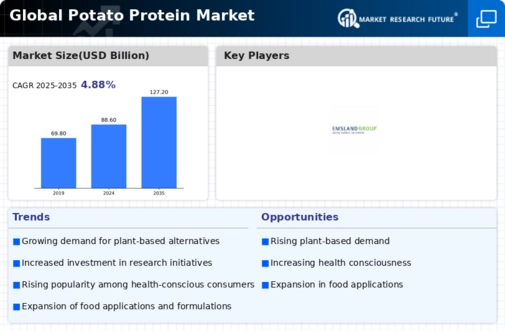Market Analysis
In-depth Analysis of Potato protein market Industry Landscape
The market dynamics of potato protein are experiencing significant changes, driven by a combination of factors that reflect the growing demand for plant-based protein alternatives, increased awareness of health and sustainability, and advancements in food technology. Potato protein, derived from potatoes, has gained prominence as a valuable protein source in various industries, including food and beverages, animal feed, and pharmaceuticals. One key driver of the market is the rising popularity of plant-based diets and the increasing demand for alternative protein sources. As consumers seek healthier and more sustainable food options, potato protein has emerged as a versatile and nutritious choice, addressing the need for plant-based protein alternatives in various applications.
The food and beverage industry plays a central role in shaping the market dynamics of potato protein. With the surge in demand for plant-based products, food manufacturers are incorporating potato protein into a diverse range of products, including meat alternatives, dairy alternatives, and snack items. This trend is driven not only by the desire to cater to vegetarian and vegan consumers but also by the functional properties of potato protein, such as its emulsifying and binding capabilities. As a result, the market dynamics reflect a growing integration of potato protein in the formulation of a wide variety of food products.
The increasing awareness of health and sustainability influences the market dynamics of potato protein. Consumers are becoming more conscious of the nutritional content of their food and the environmental impact of their dietary choices. Potato protein, being a plant-based and sustainable protein source, aligns with these consumer preferences. The market responds to this demand by positioning potato protein as a clean-label, allergen-free, and environmentally friendly ingredient, thereby contributing to its expanding role in the broader protein market.
The animal nutrition sector also significantly contributes to the market dynamics of potato protein. As a high-quality protein source, potato protein is utilized in animal feed formulations to enhance the nutritional profile of livestock and pet food. The demand for protein-rich animal feed, coupled with the desire to reduce reliance on traditional protein sources like soy, has led to increased adoption of potato protein in the animal nutrition industry, influencing market dynamics within the agriculture and livestock sectors.
Technological advancements in extraction and processing methods contribute to the evolving market dynamics of potato protein. Innovations in protein isolation and purification techniques result in improved product quality, functionality, and cost-effectiveness. These advancements expand the application possibilities of potato protein in various industries, enhancing its market dynamics by making it more versatile and commercially viable.
Global trade and international market dynamics also impact the potato protein market, as the sourcing and availability of raw materials from different regions influence pricing and supply chains. Fluctuations in commodity markets, trade agreements, and geopolitical factors contribute to the overall market dynamics, requiring industry stakeholders to navigate and adapt to changing global conditions.
Challenges within the market dynamics of potato protein include potential competition from other plant-based protein sources and the need for increased consumer education regarding the nutritional benefits of potato protein. Additionally, addressing scalability and sustainability concerns in potato cultivation for protein extraction is crucial for long-term market growth.




Leave a Comment